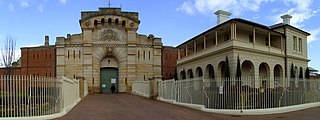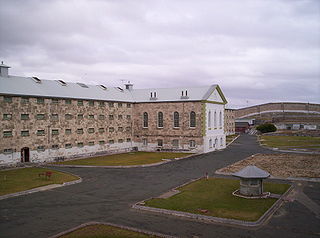
Matthew Brady was an English-born convict who became a bushranger in Van Diemen's Land. He was sometimes known as "Gentleman Brady" due to his good treatment and fine manners when robbing his victims.
Richmond is a town in Tasmania about 25 km north-east of Hobart, in the Coal River region, between the Midland Highway and Tasman Highway. At the 2006 census, Richmond had a population of 880.

HM Prison Barwon or informally Barwon Prison, an Australian high risk and maximum security prison for males, is located 6 kilometres (3.7 mi) from the township of Lara, near Geelong, Victoria, Australia. The facility is operated by Corrections Victoria. The prison provides accommodation and services for remand and sentenced prisoners detained under Victorian and Federal legislation.

The Old Melbourne Gaol is a former jail and current museum on Russell Street, in Melbourne, Victoria, Australia. It consists of a bluestone building and courtyard, and is located next to the old City Police Watch House and City Courts buildings, and opposite the Russell Street Police Headquarters. It was first constructed starting in 1839, and during its operation as a prison between 1845 and 1924, it held and executed some of Australia's most notorious criminals, including bushranger Ned Kelly and serial killer Frederick Bailey Deeming. In total, 133 people were executed by hanging. Though it was used briefly during World War II, it formally ceased operating as a prison in 1924; with parts of the jail being incorporated into the RMIT University, and the rest becoming a museum.

Risdon Prison Complex is an Australian medium to maximum security prison for males located in Risdon Vale near Hobart, Tasmania. The facility is operated by the Tasmanian Prison Service, an agency of the Department of Justice of the Government of Tasmania. The facility accepts criminals convicted under Tasmanian and/or Commonwealth legislation.
The Hobart Reception Centre, formerly the Hobart Remand Centre, an Australian maximum security prison for male and female inmates held on remand, is located in Hobart, Tasmania. The facility is operated by the Tasmanian Prison Service, an agency of the Department of Justice of the Government of Tasmania. The facility accepts felons charged under Tasmanian and/or Commonwealth legislation pending legal proceedings; and also detains convicted felons, pending their classification and placement at other correctional facilities in Tasmania.
Mary Hutchinson Women's Prison, formerly Risdon Women's Prison, an Australian minimum to maximum security prison for females, is located in Risdon Vale, Tasmania. The facility is operated by the Tasmanian Prison Service, an agency of the Department of Justice of the Government of Tasmania. The facility accepts felons convicted under Tasmanian and/or Commonwealth legislation.

H.M. Gaol Hobart or Campbell Street Gaol, a former Australian maximum security prison for males and females, was located in Hobart, Tasmania. Built by convict labour, the gaol operated between 1821 until the early 1960s. In 1961, male inmates were transferred to the H.M. Risdon Prison and in 1963, female inmates were transferred to the Risdon Women's Prison.

The Silverwater Correctional Complex, an Australian maximum and minimum security prison complex for males and females, is located in Silverwater, 21 km (13 mi) west of the Sydney central business district in New South Wales, Australia. The complex is operated by Corrective Services NSW, an agency of the New South Wales Government Department of Communities and Justice.

Bathurst Correctional Centre, originally built as Bathurst Gaol in 1888, is a prison for men and women located in the city of Bathurst, New South Wales, Australia, and operated by the Department of Communities and Justice. Bathurst holds inmates sentenced under State or Australian criminal law, along with a small number of remand prisoners.

Oatlands is an important historical village on the shores of Lake Dulverton in the centre of Tasmania, Australia. Oatlands is located 84 km north of Hobart and 115 km south of Launceston on the Midland Highway. At the 2021 census, Oatlands had a population of 728.

Thomas Jeffrey was a convict bushranger, murderer, and cannibal in the mid-1820s in Van Diemen's Land. In contemporary newspaper reports of his crimes, he was frequently described as a 'monster'. Jeffrey and three other convicts absconded from custody in Launceston in December 1825 and were subsequently responsible for five murders characterised by extreme violence, including the killing of a five-month-old infant. Another victim was a member of the gang, killed while he slept and his flesh consumed by his companions. Jeffrey was captured in January 1826; he was tried in Hobart and convicted of various of his crimes. Jeffrey was executed by hanging at Hobart in May 1826.
John Lee Archer was the Civil Engineer and Colonial Architect in Van Diemen's Land, serving from 1827 to 1838. During his tenure, Archer was responsible for all Tasmanian government buildings including those for penal and military purposes.

The Alexander Maconochie Centre is an Australian prison in the Australian Capital Territory, which detains maximum security, minimum security and remand inmates, both male and female. It is located in Hume, Australian Capital Territory. The facility is operated by ACT Corrective Services, an agency of the Government of the Australian Capital Territory. The facility accepts remandees charged under Territory and/or Commonwealth legislation pending legal proceedings; and also detains convicted offenders who are sentenced to full-time imprisonment.

Punishment in Australia arises when an individual has been accused or convicted of breaking the law through the Australian criminal justice system. Australia uses prisons, as well as community corrections. When awaiting trial, prisoners may be kept in specialised remand centres or within other prisons.

Henry Beresford Garrett (c. 1818 – 3 September 1885) was a habitual criminal who served prison sentences in England, Tasmania, Victoria and New Zealand. Born Henry Rouse, he used a number of aliases including 'Long Harry' and Henry Beresford Garrett.
Crime in Tasmania has existed since the earliest days of the European settlement in 1803. Laws creating criminal offences are contained entirely in statutes, statutory regulations, and by-laws, common law offences having been abolished by the Criminal Code Act 1924 s 6. Most offences are enforced by Tasmania Police, although a small category of offences are prosecuted by other statutory authorities such as local governments, and the Tasmanian branch of RSPCA Australia. All offences are prosecuted through the Tasmanian justice system, and sentences of imprisonment are administered by the Tasmania Prison Service. Some crime statistics for Tasmania are provided on the Tasmania Police website.

William Bannon was an Irishman who served in the British 65th Regiment of Foot in the New Zealand Wars in the 1840s. In 1849 he was found guilty of desertion and theft and was sentenced to transportation for seven years to Van Diemen's Land. A reward was posted for Bannon's capture after he escaped from a prison in Van Diemen's Land and, following his capture, he was transported to Norfolk Island before returning to Australia. "Murdering Gully Rd" at Table Cape, Tasmania is named after a murder that Bannon was accused of committing in 1858.

Edward Cornelius was an Australian convicted murderer and petty criminal. His criminal record began in his mid-teenage years and he served his first prison sentence three years later. He was convicted of killing Rev. H. Laceby Cecil during a robbery of a vicarage in the inner Melbourne suburb of Collingwood. Cornelius was executed at Pentridge Prison, Victoria in June 1936, the third of eleven people to be hanged there after the closure of Melbourne Gaol in 1924.














